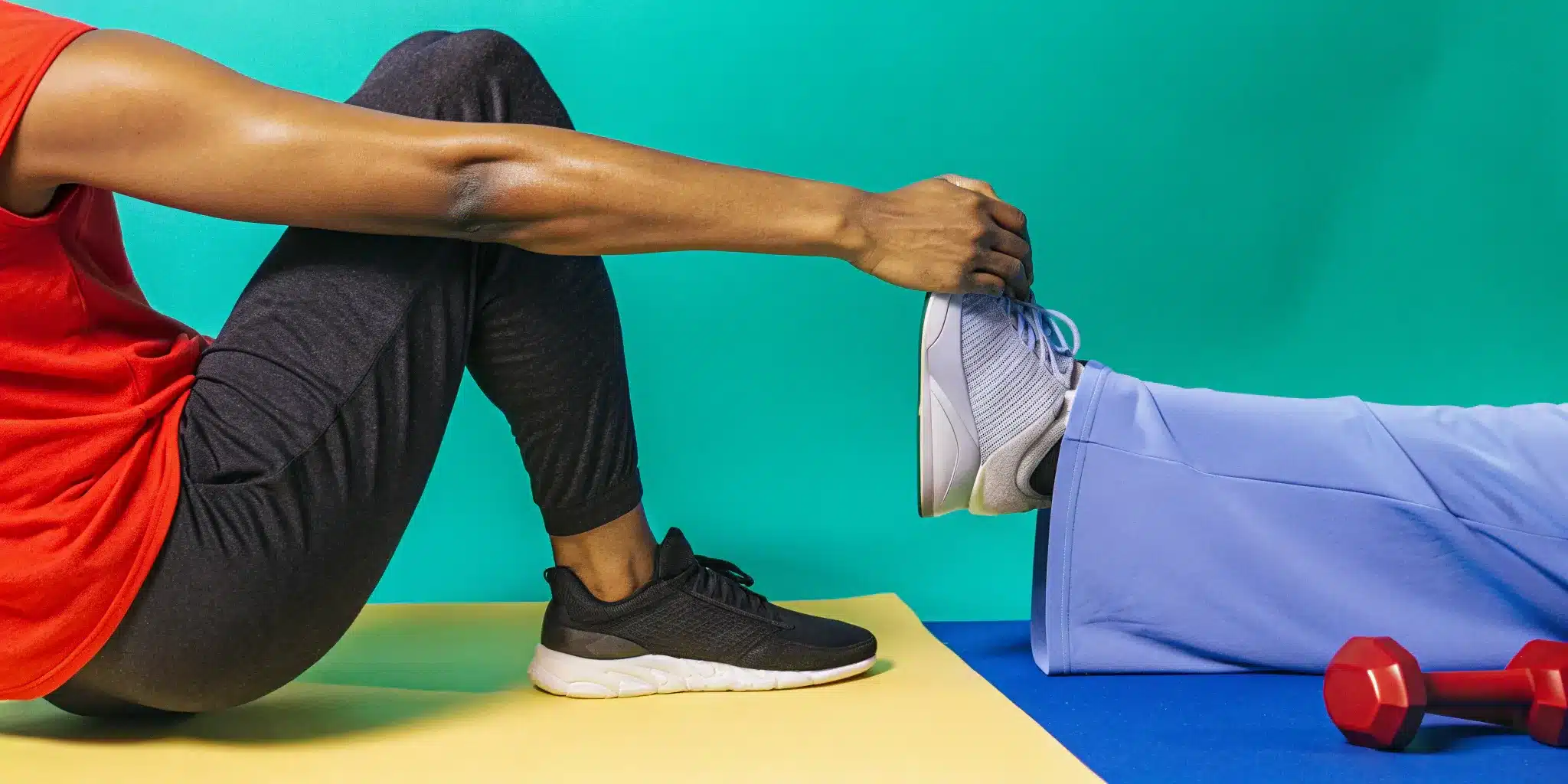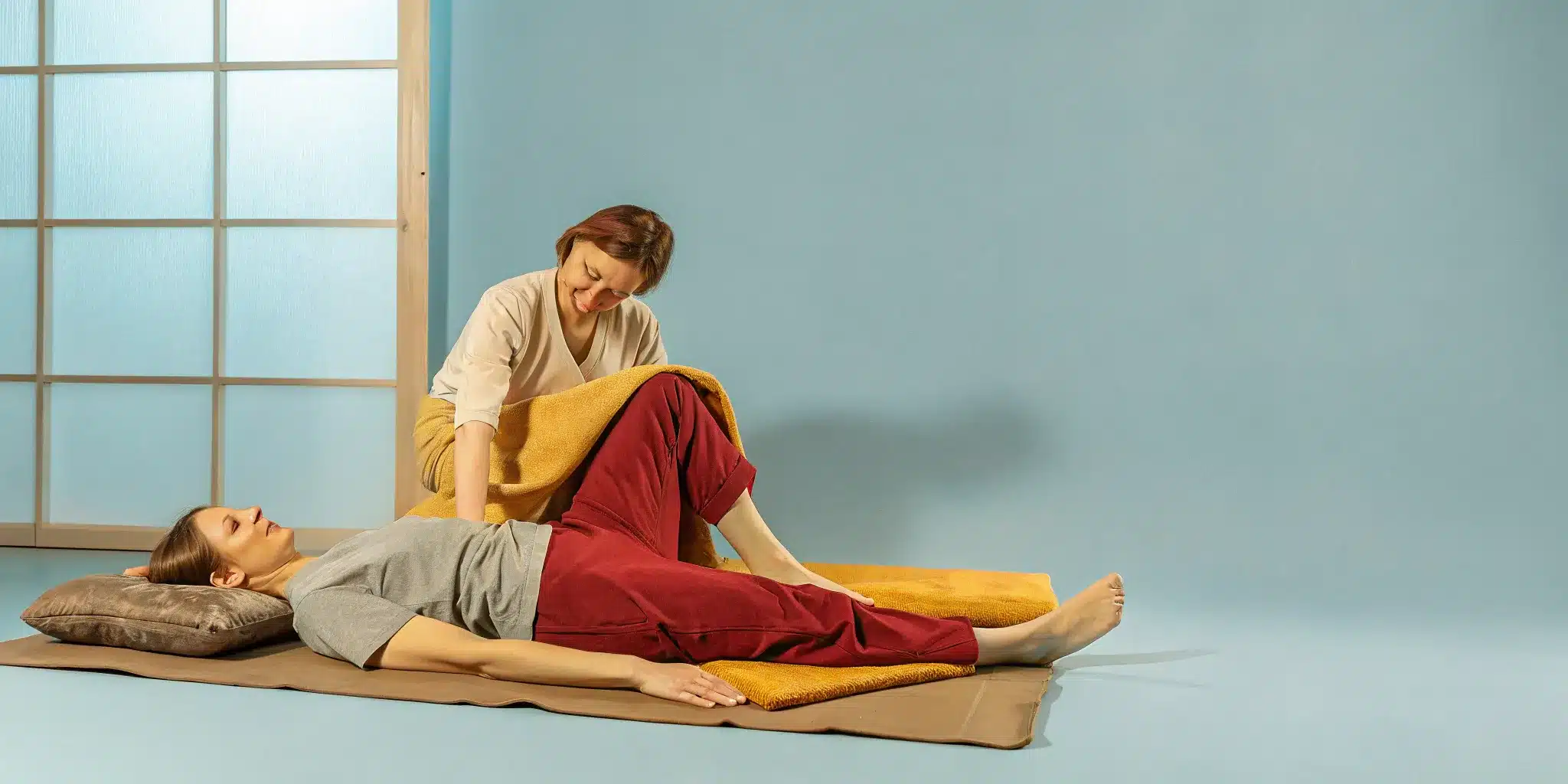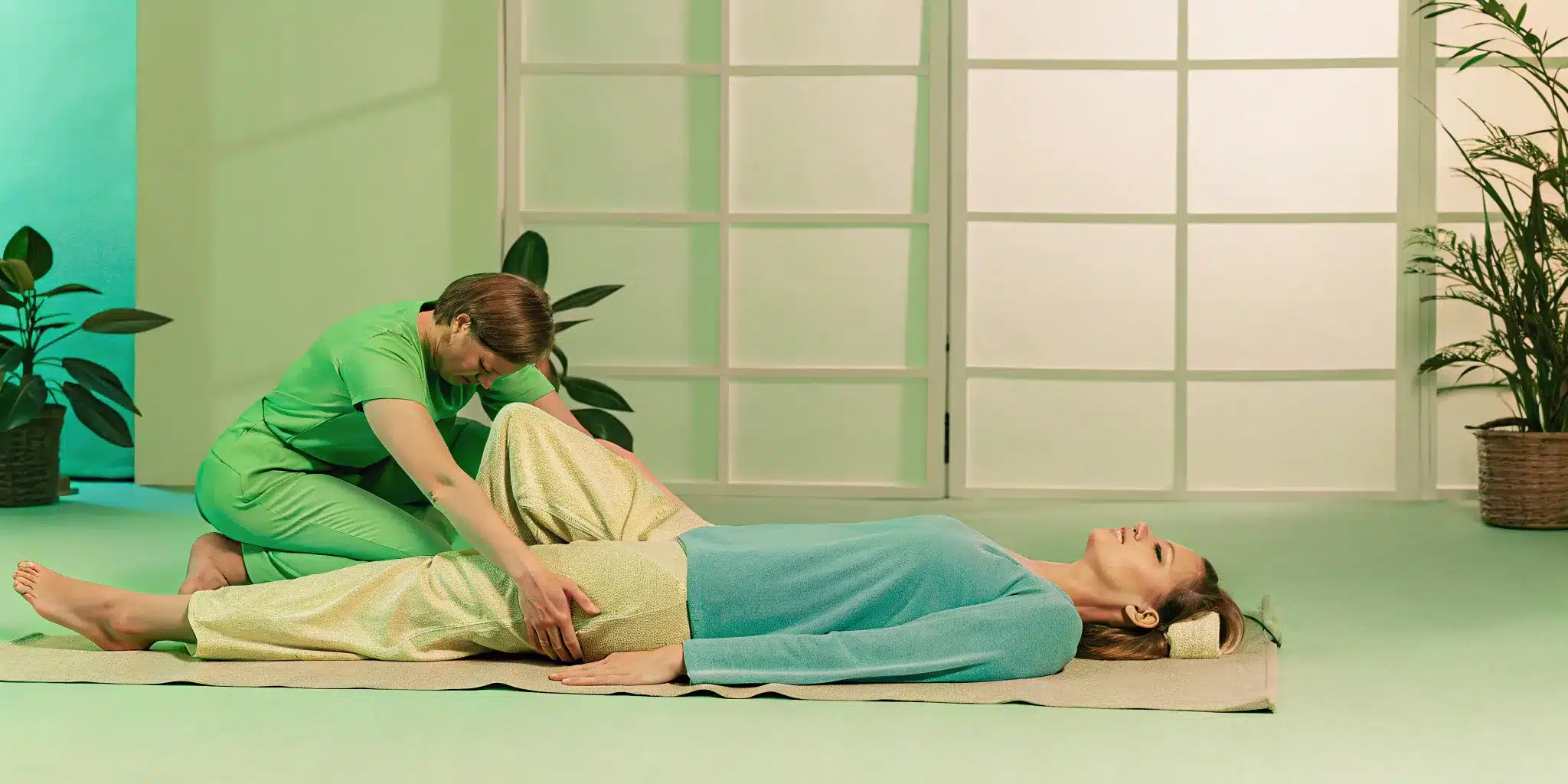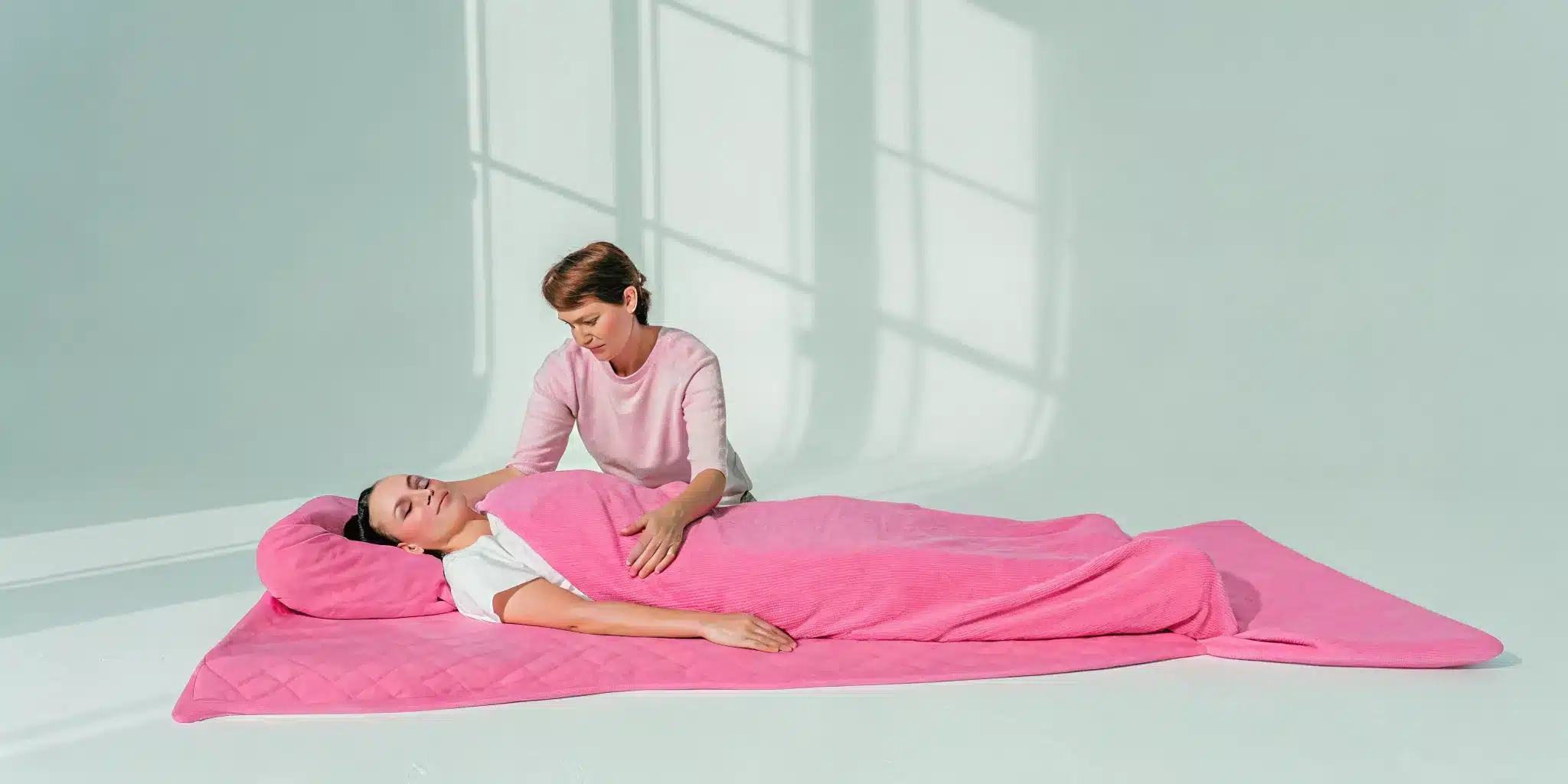Waking up with stiff hips or feeling a twinge in your back when you bend down can make movement feel like a chore. For many of us dealing with chronic aches, the idea of stretching can seem daunting. But what if the right kind of movement could actually be the solution? Dynamic stretching is a gentle, active way to ease your body into the day. It focuses on controlled, flowing movements that increase blood flow and warm up your muscles without forcing them into uncomfortable positions. This approach is perfect for anyone looking to improve their mobility. Learning a few simple dynamic stretching legs exercises can help you feel less restricted and move with more confidence.
Key Takeaways
- Warm Up with Active Movements: Dynamic stretching involves moving your legs through their full range of motion, not just holding a pose. This active approach increases blood flow and warms up your muscles, which is the best way to prepare your body for activity and reduce the risk of injury.
- Match Your Stretches to Your Activity: Perform dynamic stretches right before your workout, after a 3-5 minute light cardio session. The key is to choose movements that mimic what you’re about to do, like leg swings for running or bodyweight squats for strength training, to prepare the right muscles for the job.
- Focus on Form, Not Force: The goal is smooth, controlled movement, not speed or pushing into pain. A stretch should feel like a gentle release, never sharp or stabbing. Listening to your body and moving with intention is the safest way to improve your mobility and feel better long-term.
What Are Dynamic Leg Stretches?
If you’ve ever thought stretching just means holding a pose for 30 seconds, it’s time to meet dynamic stretching. Dynamic leg stretches are active movements designed to prepare your muscles and joints for whatever you’re about to do, whether that’s a workout or just a busy day. Instead of holding a position, you’ll be moving your legs through their full range of motion. This process gets your blood pumping, warms up your muscles, and tells your nervous system it’s time to get moving. Think of it as a gentle wake-up call for your lower body.
Dynamic vs. Static Stretching: What’s the Difference?
The main difference between dynamic and static stretching comes down to one thing: movement. Dynamic stretching is an active form of stretching that uses controlled movements to take your joints and muscles through a full range of motion. It’s perfect for warming up the body. Static stretching, on the other hand, is passive. It’s the classic “stretch and hold” you probably learned in gym class. While static stretches are great for cooling down and improving flexibility after a workout, dynamic stretches are what your body needs before activity. They actively engage your muscles, increasing blood flow and getting your body ready for what’s next.
Why They Improve How You Move
The biggest benefit of dynamic leg stretches is how they enhance your mobility. By actively moving your joints, you can increase their range of motion, which allows for more fluid, efficient movements. This is crucial for reducing the risk of injury, especially those caused by muscle stiffness or lack of preparation. When your hips, knees, and ankles can move more freely, everyday activities like walking, climbing stairs, or bending down to pick something up feel easier and more comfortable. It’s not just about athletic performance; it’s about improving your quality of movement in daily life and feeling less restricted in your own body.
How Do They Actually Work?
Dynamic stretching works by sending a signal to your body that it’s time to prepare for activity. The continuous movement increases blood flow to your muscles, delivering the oxygen and nutrients they need to perform well. This process also raises your muscle temperature, making them more pliable and less prone to strains. Furthermore, by mimicking the types of movements you’ll be doing in your workout or activity, you’re essentially giving your muscles a rehearsal. This helps activate the correct muscle patterns and improves the connection between your brain and your body, leading to better coordination and overall performance.
The Science: Why Your Body Loves Dynamic Stretching
Ever wonder what’s actually happening inside your body when you do a few leg swings or walking lunges? It’s more than just shaking out the cobwebs. Dynamic stretching is a powerful conversation with your nervous system, muscles, and joints, telling them it’s time to get ready for action. This active approach to warming up does some incredible things behind the scenes to prepare you for movement, reduce your risk of getting hurt, and help you feel your best, whether you’re heading out for a walk or getting ready for a workout. Understanding the science behind it can make the practice feel less like a chore and more like a gift to your body. Let’s look at why your body responds so well to these movements.
Wake Up Your Muscles and Get Blood Flowing
Think of your muscles like a car engine on a cold morning—you wouldn’t just start it and immediately redline it. Dynamic stretching is the equivalent of letting that engine warm up. These gentle, repetitive movements increase your heart rate and get more oxygen-rich blood flowing to warm up your muscles. This process does more than just make you feel warmer; it makes your muscle fibers more pliable and ready to contract and lengthen efficiently. This preparation is key for getting the most out of any activity and helps your body perform at its best from the very first step.
Improve Your Range of Motion
If you want to move more freely, dynamic stretching is one of the best tools you have. Unlike static stretching where you hold a position, dynamic stretching takes your joints through their full range of motion. It’s a form of active stretching that tells your nervous system, “Hey, it’s safe to move this way!” Over time, this helps your brain become more comfortable with deeper ranges of motion, which translates into better flexibility and mobility in your daily life. You’ll find it easier to bend down, reach up, and move with a fluidity you may not have felt in years.
How to Prevent Injuries Before They Happen
One of the biggest benefits of a good warm-up is injury prevention, and dynamic stretching is a star player here. When your muscles are cold and stiff, they’re much more susceptible to pulls, strains, and tears. By increasing blood flow and warming up the muscle tissue, dynamic stretching makes your muscles more elastic and resilient. It also helps enhance joint range of motion, allowing for smoother, more controlled movements. This preparation means your body is less likely to be shocked by a sudden movement, significantly reducing your risk of injury during your workout or any physical activity.
When and How to Use Dynamic Stretches
Knowing which dynamic stretches to do is only half the story. To get the full benefits—like better mobility and fewer injuries—you also need to know when and how to use them. Timing is everything. Performing these active movements at the right moment can make the difference between a great workout and a potential strain. Think of dynamic stretching as the specific preparation your body needs before it performs. It’s about activating the exact muscles you’re about to use, improving communication between your brain and your body, and getting your joints ready for what’s next.
The Best Time to Stretch
The ideal time to perform dynamic stretches is right before you exercise, as a key part of your warm-up. Think of it as a gentle wake-up call for your body. These movements increase your heart rate and body temperature, sending more oxygen-rich blood to your muscles. This process effectively prepares them for activity, helping to improve your strength, flexibility, and overall performance. Unlike static stretching, where you hold a position for an extended period, dynamic stretching keeps you moving. This active approach is exactly what your muscles need before you ask them to run, jump, or lift. Save the long, relaxing holds for your cool-down after your workout is complete.
Where Stretching Fits in Your Warm-Up
Dynamic stretches are a core component of a good warm-up, but they shouldn’t be the very first thing you do. It’s best to start with three to five minutes of light cardio—like jogging in place, jumping jacks, or a brisk walk—to get your blood pumping. Once you feel a little warmer, you can move into your dynamic stretching sequence. This one-two punch ensures your muscles are receptive and ready to move. Performing dynamic stretches at this stage helps stabilize your muscles and encourages a full range of motion, which is essential for performing exercises correctly and safely. This prepares your joints and connective tissues for the more intense work ahead.
Tailor Your Stretches to Your Workout
For dynamic stretching to be most effective, it should be specific to the activity you’re about to do. The goal is to mimic the movements you’ll be performing during your workout, just at a lower intensity. By practicing these sports-specific movements, you ensure the right muscles are activated and ready for action. For example, if you’re going for a run, focus on leg swings, butt kicks, and walking lunges. If you’re planning to lift weights and do squats, prioritize bodyweight squats and hip circles to open up your hips. This targeted approach not only gets your body ready but also reinforces proper movement patterns, leading to better performance.
10 Essential Dynamic Leg Stretches to Try
Ready to get moving? Here are ten simple yet effective dynamic stretches to add to your warm-up routine. We’ve broken them down by the muscle groups they target so you can focus on what your body needs most. Remember to move with control and intention—the goal is to warm up your muscles, not force them into a position they aren’t ready for. Listen to your body, breathe through each movement, and focus on how you feel. These stretches are designed to prepare your legs for whatever activity you have planned, from a walk around the block to a full-on workout.
For Your Hips and Glutes
Tight hips and sleepy glutes can contribute to everything from back pain to poor posture. Waking them up before you move is key. Dynamic stretching gets your blood flowing and prepares these crucial muscles for activity, which helps improve your strength and flexibility.
- Leg Swings (Forward and Backward): Stand next to a wall for support. Swing one leg forward and backward like a pendulum, keeping your core engaged. Do 10–15 swings per leg.
- Leg Swings (Side-to-Side): Face the wall and swing your leg from side to side in front of your body. This helps open up your hip adductors and abductors. Do 10–15 swings per leg.
- Gate Openers: While walking, lift your knee to hip height and rotate it outward, as if you’re opening a gate. Alternate legs with each step for 10 reps per side.
For Your Hamstrings and Quads
Your hamstrings and quads are the powerhouses of your legs, and they deserve a proper warm-up. Dynamic stretches are perfect for this because they help stabilize these muscles and prepare them for a full range of motion.
- Frankenstein Walks: Walk forward, kicking one leg straight out in front of you while reaching with the opposite hand toward your toes. Keep your back straight and your leg as straight as you comfortably can. Take 10 “steps” on each leg.
- Walking Quad Stretch: Take a step forward, then reach back to grab your back foot and gently pull your heel toward your glute. Hold for a second, release, and step forward to switch sides. This gently stretches the front of your thigh.
For Your Calves and Ankles
Your calves and ankles provide the foundation for almost every move you make. Giving them some attention before a workout can improve your stability and agility. These active movements are designed to warm up your muscles and gently increase your range of motion without overstretching.
- Ankle Rotations: Stand on one leg (hold onto something for balance if needed) and rotate your other ankle in circles. Do 10 circles in each direction, then switch feet. This simple move lubricates the ankle joint.
- Walking Calf Raises: As you walk, consciously push off the ball of your foot with each step, rising onto your toes. This activates your calf muscles and prepares them for impact. Do this for about 30 seconds.
Stretches to Engage Your Entire Leg
Some days you need a quick, efficient warm-up that hits all the major muscle groups at once. These movements actively engage your lower body, improve your mobility, and get your heart rate up slightly, preparing you for peak performance.
- Walking Lunges with a Twist: Step forward into a lunge, making sure your front knee doesn’t go past your toes. As you lunge, twist your torso over your front leg. Push off and step into the next lunge with the opposite leg. Do 10 lunges per side.
- High Knees: Walk or jog in place, bringing your knees up toward your chest. Keep your core tight and land softly on the balls of your feet. This is a great way to elevate your core temperature and get your whole body ready to work.
Common Mistakes (And How to Fix Them)
The most common mistake is also the easiest to fix: stretching cold muscles. It’s essential to get your blood flowing before you ask your muscles to lengthen. As experts from the Kansas Health System advise, “Before you stretch, do an activity that makes you sweat a little, like walking, jogging, or biking.” Just five minutes of light cardio is all it takes. Another pitfall is rushing through the movements. Dynamic stretching isn’t about speed; it’s about control. Focus on smooth, deliberate motions instead of bouncing or using momentum. This ensures you’re warming up the muscle, not putting it at risk of injury.
Build Your Perfect Dynamic Stretching Routine
Creating a dynamic stretching routine that works for you is all about consistency, not complexity. You don’t need a long, complicated sequence to get the benefits. The goal is to build a simple, effective warm-up that you can stick with. Think of it as a conversation with your body—a way to check in and gently prepare your muscles for whatever you have planned, whether it’s a workout, a walk, or just a busy day. A good routine feels energizing and leaves you feeling more connected to your body and ready to move with confidence.
A Simple Sequence to Get You Started
The best dynamic stretches are movements that mimic the activity you’re about to do. This helps prepare your muscles for the specific demands you’ll place on them. If you’re new to this, start with a basic flow that targets the major muscle groups in your legs. Try performing 10-12 reps of each of these exercises in order:
- Leg Swings (Forward and Back): Hold onto a wall for balance and swing one leg forward and backward.
- Leg Swings (Side to Side): Face the wall and swing your leg from side to side in front of your body.
- Walking Lunges: Step forward into a lunge, then bring your back foot forward to step into the next lunge.
- High Knees: Walk or jog in place, bringing your knees up toward your chest.
How to Level Up Your Stretches
Once you feel comfortable with a basic routine, you can start to challenge yourself. The key is to focus on gradually enhancing your joint range of motion. This doesn’t mean pushing into pain, but rather exploring a slightly deeper stretch or a more complex movement. For example, you could add a torso twist to your walking lunges to engage your core and spine. Or, you could try increasing the height of your leg swings. Small, consistent progressions are what help reduce muscle stiffness and allow for more fluid, pain-free movement over time.
How Long and How Many?
You don’t need to spend a ton of time on your warm-up to make it effective. A focused dynamic stretching routine should last about 10 to 15 minutes. This is the sweet spot for increasing blood flow, warming up your muscle tissues, and improving your flexibility before you start your main activity. Aim to include about 5 to 10 different dynamic stretches in your sequence. For each stretch, perform around 10 to 12 repetitions per side or for a duration of about 30 seconds. This ensures you’re activating your muscles without fatiguing them before your workout even begins.
Make the Routine Your Own
The most effective routine is one that’s tailored to your body and your goals. Pay attention to areas that feel particularly tight or weak and choose stretches that address those spots. If your hips are always stiff, spend a little more time on leg swings and hip circles. If you’re a runner, focus on movements like walking lunges and butt kicks. Personalizing your warm-up ensures you’re getting exactly what you need. A routine designed for you will not only warm up your muscles but can also improve your strength and performance in the long run.
The Best Stretches for Your Favorite Activities
Your warm-up shouldn’t be one-size-fits-all. The best dynamic stretching routine is one that’s tailored to the activity you’re about to do. Whether you’re heading out for a run, hitting the weight room, or just looking to feel better on a recovery day, preparing your body with the right movements makes all the difference. Think of it as giving your muscles a specific heads-up for the job they’re about to do. This targeted approach not only helps you perform better but also keeps you moving safely and comfortably, reducing your risk of injury and helping you get the most out of every session.
For Runners and Walkers
If you’re a runner or walker, your legs are your engine. A proper warm-up is non-negotiable for keeping that engine running smoothly. Dynamic leg stretches actively engage your lower body, warming up your glutes, hamstrings, quads, and calves. These movements increase blood flow and elevate your core temperature, signaling to your body that it’s time to work. This preparation helps improve your range of motion, allowing for a more efficient and powerful stride. Taking just five minutes to perform movements like leg swings and walking lunges can make a huge difference in your peak performance and help prevent common running-related injuries.
For Lifting and Strength Training
Heading into a strength training session with cold, stiff muscles is a recipe for injury. Before you even think about picking up a weight, you need to prepare your body for the demands of the workout. Dynamic stretching is perfect for this because it gets your blood pumping and wakes up the muscles you’re about to target. Unlike holding a static stretch, these active movements prepare your joints and muscles for lifting, which can improve your strength, flexibility, and overall performance. Stretches like bodyweight squats and hip circles get your hips and legs ready for action, ensuring you can move through each lift with proper form and control.
For Sports and Athletic Performance
For activities that require quick, explosive movements—like tennis, soccer, or basketball—your warm-up needs to be just as dynamic as your sport. Dynamic stretching enhances your joint range of motion, which is crucial for agility and making sharp cuts or pivots. By mimicking the specific movements you’ll use in the game, you’re essentially giving your muscles a dress rehearsal. This primes your neuromuscular system, ensuring your body is ready to react quickly and powerfully. Better preparation leads to better physical performance and reduces the risk of injuries like muscle strains that can happen when you go from zero to one hundred too quickly.
Using Dynamic Stretches for Recovery
Stretching isn’t just for warm-ups. On your rest days or after a tough workout, gentle dynamic movements can be an excellent tool for active recovery. The goal here isn’t to prep for intense activity but to gently move your body to ease stiffness and promote blood flow to sore muscles. Think slow, controlled leg swings or gentle walking lunges. These active movements help increase your range of motion without putting too much strain on tired muscles. Integrating these exercises into your cool-down or your off-day workout routine can help reduce muscle soreness and keep you feeling mobile and ready for your next session.
Ready for a Challenge? Advanced Techniques
Once you’ve gotten comfortable with the basic dynamic leg stretches, you might feel ready to take things to the next level. Advancing your routine isn’t about pushing through pain; it’s about moving with more intention, control, and variety. These techniques will help you deepen your practice, improve your mobility even further, and keep your warm-ups feeling fresh and effective. Think of it as the next chapter in your journey toward moving well and feeling your best.
Try More Complex Movements
If you’ve mastered the foundational movements, it’s time to introduce more complex patterns. This means combining stretches or adding elements that challenge your coordination and balance. For example, you could progress from a simple forward leg swing to a forward leg swing with a torso twist, engaging your core and upper body. These multi-joint movements are fantastic because they more closely mimic the demands of sports and daily life. By incorporating more intricate sequences, your body learns to move as a cohesive unit, which enhances joint range of motion and prepares your muscles for more demanding activities, leading to more fluid, efficient movement.
How to Safely Increase Intensity
Ready to turn up the dial? Increasing intensity doesn’t mean forcing a stretch or moving aggressively. Instead, focus on gradually expanding your range of motion with each repetition. For instance, with each leg swing, try to go a little higher without sacrificing your form. You can also slightly increase the speed of your movements, as long as they remain smooth and controlled. Unlike static stretching where you hold a position, dynamic stretching engages your muscles in movement, which is key for warming up your body. The most important rule is to listen to your body—you should feel a gentle stretch, never sharp pain.
Mix Dynamic and Static Stretches
Understanding when to use dynamic versus static stretching is a game-changer for your overall mobility and recovery. Think of it this way: dynamic stretches are for your warm-up, and static stretches are for your cool-down. Dynamic movements prepare your body for action; they wake up your nervous system, increase blood flow, and help stabilize muscles before a workout. Static stretches, where you hold a position for 20-30 seconds, are best saved for after your workout. They help release tension, improve flexibility over time, and signal to your body that it’s time to start the recovery process.
Create Your Own Mobility Flow
One of the best ways to make your routine more engaging is to create your own mobility flow. This involves stringing several dynamic stretches together into one continuous, seamless sequence. Pick three to five of your favorite leg stretches and practice moving smoothly from one to the next without pausing. For example, you could flow from walking knee hugs into walking quad stretches, then into Frankenstein walks. Creating a flow turns your warm-up into a mindful practice that focuses on breath and movement. These active movements that warm up your muscles not only prepare you for exercise but also improve your agility for everyday life.
Stretch Safely: Perfect Your Form
Getting the most out of your stretching routine isn’t just about going through the motions—it’s about doing them correctly. Proper form is your best defense against injury and the secret to actually feeling better. When you focus on how you move, you’re not just warming up your muscles; you’re building a stronger connection between your mind and body. This awareness helps you understand your limits, move with more confidence, and target the right areas to relieve pain and stiffness.
Think of it as a conversation with your body. Each stretch is a chance to listen to what it needs. Rushing through your routine with sloppy form can do more harm than good, potentially leading to strains or pulls. Instead, slowing down and prioritizing quality over quantity will help you achieve a deeper, more effective stretch. By focusing on a few key principles—like controlled movements, steady breathing, and proper alignment—you can transform your warm-up from a simple checklist item into a powerful tool for improving your mobility and overall well-being. Below, we’ll cover the essential checkpoints to ensure every stretch you do is both safe and effective.
Focus on Controlled Movements
When it comes to dynamic stretching, think smooth and steady, not fast and jerky. The goal is to use active movements that gently take your joints and muscles through their full range of motion. Each leg swing, torso twist, or arm circle should be deliberate and controlled. Avoid using momentum to fling your limbs around. Bouncing in a stretch, also known as ballistic stretching, can be risky and may trigger your muscles to tighten up as a protective response—the exact opposite of what you want. By moving with intention, you actively warm up your muscles, increase blood flow, and prepare your body for whatever activity is next, all while minimizing the risk of a pull or strain.
Don’t Forget to Breathe
It’s something we do all day without thinking, but conscious breathing during a stretch can make a world of difference. Many of us instinctively hold our breath when we feel tension, but this actually creates more tightness in the body. Instead, focus on taking deep, slow breaths. Inhale through your nose as you prepare for the movement, and exhale slowly as you move into the stretch. This simple act sends a signal to your nervous system to relax, which in turn allows your muscles to release and lengthen more effectively. Deep breathing also ensures your muscles are getting the oxygen they need to function at their best, helping you ease into a deeper, more restorative stretch.
Key Checkpoints for Good Form
Maintaining good posture and alignment is crucial for an effective stretch. Before you begin each movement, take a moment to check in with your body. Are your shoulders relaxed and away from your ears? Is your spine in a neutral position, not overly arched or rounded? Engaging your core can help stabilize muscles and protect your lower back. As you move through a stretch, pay attention to where the movement is coming from. For example, in a leg swing, the motion should originate from your hip joint, not from twisting your back. Good form ensures you’re targeting the intended muscles and not putting unnecessary strain on other parts of your body.
How to Know If You’re Doing It Wrong
Stretching should feel good—or at the very least, like a gentle release of tension. It’s normal to feel a mild pulling sensation in the muscle you’re targeting. However, you should never feel sharp, stabbing, or radiating pain. Pain is your body’s warning signal that something is wrong. If you feel it, you’re likely pushing your body past its limits, which can easily lead to injury. The moment you feel pain, ease off the stretch immediately. Remember, the goal is to work with your body, not against it. Listening to its signals and respecting your current level of flexibility is the smartest and safest way to make long-term progress.
Make Dynamic Stretching a Daily Habit
Turning dynamic stretching into a consistent habit is one of the best things you can do for your body. When you make these movements a regular part of your day, you’re not just warming up for a workout; you’re investing in long-term mobility, reducing chronic pain, and helping your body feel its best. The key is to stop thinking of stretching as an isolated event and start weaving it into the small moments you already have. Whether you’re starting your morning, getting ready for a workout, or just taking a break from your desk, a few minutes of intentional movement can completely change how you feel. By making it a simple, non-negotiable part of your routine, you’ll build a foundation for better movement and less stiffness for years to come.
Start Your Day with a Morning Routine
Imagine starting your day feeling fluid and ready instead of stiff and sore. Adding a few dynamic stretches to your morning can make that a reality. Just five minutes of gentle movement gets your blood flowing, warms up your muscles, and prepares your body for whatever the day holds. This simple practice helps set a positive tone for your physical and mental well-being. Try a few walking lunges down the hallway, some gentle leg swings while you wait for your coffee to brew, or hip circles to wake up your joints. You’re not aiming for an intense workout—just a simple, feel-good way to ease into the day and tell your body it’s time to move.
Prep Your Body for Any Workout
Using dynamic stretches to warm up is a total game-changer for your workouts. These movements actively prepare your body for exercise by taking your joints through their full range of motion. This process helps stabilize your muscles and gets them ready to perform, which can lead to better results and, most importantly, a lower risk of injury. Before you run, lift, or play a sport, spend some time with movements like high knees, butt kicks, and walking quad stretches. Unlike static stretching (holding a stretch), this active warm-up increases your body temperature and muscle elasticity, ensuring you’re primed and ready to go. Think of it as a crucial conversation with your body before you ask it to work hard.
Wind Down After Your Workout
While static stretching is a classic cool-down, gentle dynamic movements also have a place in your post-workout routine. After intense activity, your muscles can feel tight and stiff. Slow, controlled dynamic stretches can help maintain your joint range of motion and encourage blood flow, which aids in recovery. This allows for more fluid movements and can reduce the soreness that sometimes follows a tough workout. Consider adding a few reps of slow, deep walking lunges or gentle leg swings to your cool-down. This form of active recovery can help ease your body back to a resting state while preventing the stiffness that can set in later.
Fit Stretching into Your Everyday Life
You don’t need a yoga mat or a full hour to reap the benefits of stretching. The most effective routines are the ones you can stick with, and that often means finding small pockets of time throughout your day. By regularly incorporating stretches like dynamic hip flexors or calf raises into your daily life, you encourage muscle power and agility. This makes everyday activities feel more fluid and less strenuous. Set a reminder to do some leg swings after a long meeting, try some ankle circles while you’re sitting at your desk, or do a few squats while you’re waiting for dinner to cook. These small actions add up, helping to combat the effects of a sedentary lifestyle and keep your body feeling mobile and pain-free.
Related Articles
- How to Do PNF Stretching Exercises for Hamstrings – STRETCHMED
- 10 Benefits of Stretching: Feel & Move Better – STRETCHMED
- Benefits of a 1-on-1 Stretch Therapist: Improve Flexibility & Reduce Pain – STRETCHMED
Frequently Asked Questions
Should I do dynamic stretches if I’m already in pain? This is a great question, and the answer is to listen to your body. Gentle, controlled dynamic movements within a pain-free range can actually help ease stiffness. However, you should never push through sharp or radiating pain. If a movement hurts, ease off or stop. The goal is to feel a gentle release, not to force anything. When in doubt, it’s always best to consult with a professional who can guide you on what’s safe for your specific situation.
What’s the simplest way to remember the difference between dynamic and static stretching? Think of it this way: dynamic stretching is for “waking up” your body, and static stretching is for “calming it down.” Dynamic stretches are active movements you do before a workout to prepare your muscles for action. Static stretches are the classic “stretch and hold” poses you do after a workout to help your muscles relax and improve flexibility over time.
Do I really need to do a few minutes of cardio before my dynamic stretches? Yes, and it makes a huge difference. Think of your muscles like a piece of taffy—it’s much more pliable when it’s warm. Just three to five minutes of light activity like jogging in place or a brisk walk gets your blood flowing and takes the chill off your muscles. This makes them more receptive to stretching and helps you get more out of every movement safely.
How long should my dynamic stretching routine actually take? You don’t need to set aside a huge chunk of time. A focused and effective dynamic stretching routine should only take about 10 to 15 minutes. The key is consistency, not duration. A quality 10-minute warm-up done regularly is far more beneficial than a long, sporadic session.
Can I do dynamic stretches on my rest days? Absolutely. On days you’re not doing a formal workout, gentle dynamic stretching is a fantastic form of active recovery. Slow, controlled movements can help ease muscle soreness, reduce stiffness, and promote blood flow without putting too much stress on your body. It’s a great way to keep your joints feeling fluid and mobile every day.







